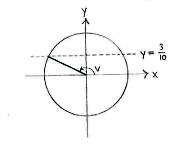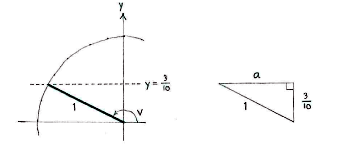Lösung 4.3:6b
Aus Online Mathematik Brückenkurs 1
K (Lösning 4.3:6b moved to Solution 4.3:6b: Robot: moved page) |
|||
| Zeile 1: | Zeile 1: | ||
| - | + | We draw an angle | |
| - | < | + | <math>v</math> |
| - | {{ | + | in the unit circle, and the fact that |
| - | { | + | <math>\text{sin }v\text{ }=\frac{3}{10}</math> |
| - | < | + | means that its |
| - | {{ | + | <math>y</math> |
| + | -coordinate equals | ||
| + | <math>\frac{3}{10}</math>. | ||
[[Image:4_3_6_b1.gif|center]] | [[Image:4_3_6_b1.gif|center]] | ||
| + | |||
| + | With the information that is given, we can define a right-angled triangle in the second quadrant which has a hypotenuse of | ||
| + | <math>\text{1}</math> | ||
| + | and a vertical side of length | ||
| + | <math>\frac{3}{10}</math>. | ||
| + | |||
| + | |||
[[Image:4_3_6_b2.gif|center]] | [[Image:4_3_6_b2.gif|center]] | ||
| + | |||
| + | We can determine the triangle's remaining side by using Pythagoras' theorem, | ||
| + | |||
| + | |||
| + | <math>a^{2}+\left( \frac{3}{10} \right)^{2}=1^{2}</math> | ||
| + | |||
| + | |||
| + | which gives that | ||
| + | |||
| + | |||
| + | <math>a=\sqrt{1-\left( \frac{3}{10} \right)^{2}}=\sqrt{1-\frac{9}{100}}=\sqrt{\frac{91}{100}}=\frac{\sqrt{91}}{10}</math> | ||
| + | |||
| + | This means that the angle's | ||
| + | <math>x</math> | ||
| + | -coordinate is | ||
| + | <math>-a</math>, i.e. we have | ||
| + | |||
| + | |||
| + | <math>\cos v=-\frac{\sqrt{91}}{10}</math> | ||
| + | |||
| + | and thus | ||
| + | |||
| + | |||
| + | <math>\tan v=\frac{\sin v}{\cos v}=\frac{\frac{3}{10}}{-\frac{\sqrt{91}}{10}}=-\frac{3}{\sqrt{91}}</math> | ||
Version vom 09:15, 10. Okt. 2008
We draw an angle \displaystyle v in the unit circle, and the fact that \displaystyle \text{sin }v\text{ }=\frac{3}{10} means that its \displaystyle y -coordinate equals \displaystyle \frac{3}{10}.
With the information that is given, we can define a right-angled triangle in the second quadrant which has a hypotenuse of \displaystyle \text{1} and a vertical side of length \displaystyle \frac{3}{10}.
We can determine the triangle's remaining side by using Pythagoras' theorem,
\displaystyle a^{2}+\left( \frac{3}{10} \right)^{2}=1^{2}
which gives that
\displaystyle a=\sqrt{1-\left( \frac{3}{10} \right)^{2}}=\sqrt{1-\frac{9}{100}}=\sqrt{\frac{91}{100}}=\frac{\sqrt{91}}{10}
This means that the angle's \displaystyle x -coordinate is \displaystyle -a, i.e. we have
\displaystyle \cos v=-\frac{\sqrt{91}}{10}
and thus
\displaystyle \tan v=\frac{\sin v}{\cos v}=\frac{\frac{3}{10}}{-\frac{\sqrt{91}}{10}}=-\frac{3}{\sqrt{91}}


